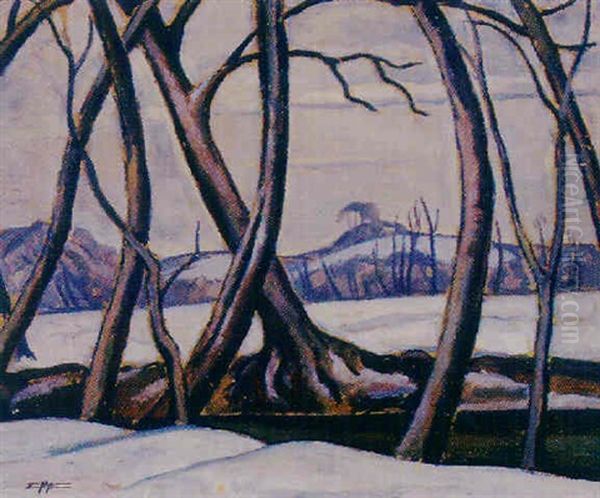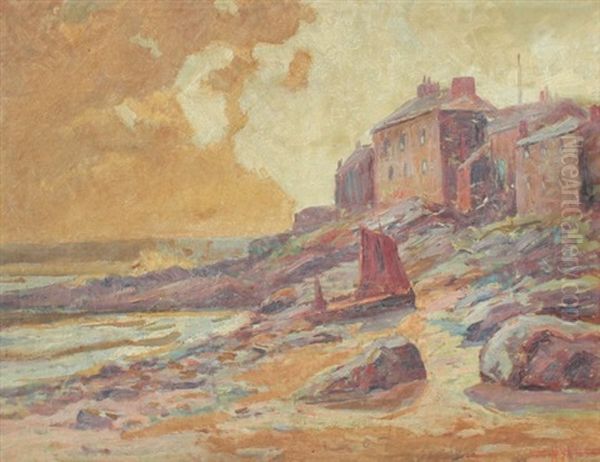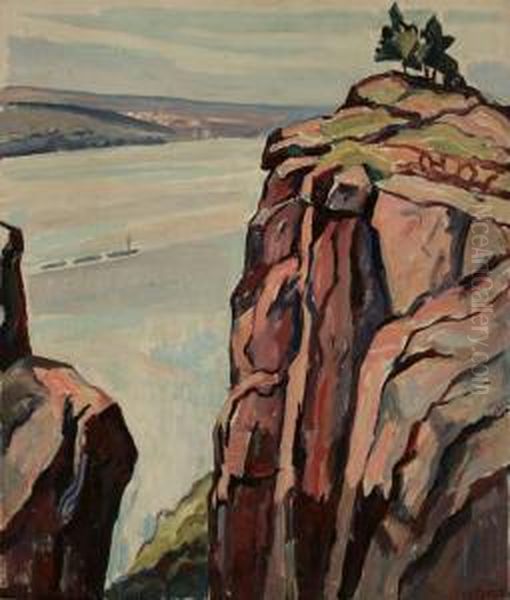Edgar Hewitt Nye stands as a significant, if sometimes overlooked, figure in the landscape of early twentieth-century American art, particularly within the vibrant and evolving artistic milieu of Washington D.C. His career, marked by dedicated study both at home and abroad, a distinctive stylistic approach, and active participation in the capital's art societies, offers a fascinating glimpse into the ways American artists absorbed and reinterpreted European modernism. Nye's life and work reflect a commitment to capturing the essence of his surroundings, filtered through a modernist sensibility that prized structure, color, and personal vision.
Early Life and Artistic Foundations
Born on April 30, 1879, in Richmond, Virginia, Edgar Hewitt Nye's artistic journey would predominantly unfold in Washington D.C., the city he would call home for most of his life. His formal artistic training began at a relatively young age, enrolling in the prestigious Corcoran School of Art in Washington D.C. He studied there from 1892 to 1900, a period that would have exposed him to a rigorous academic curriculum, likely emphasizing drawing from casts, life drawing, and traditional painting techniques. The Corcoran, even then, was a central institution in the city's cultural life, and its instructors, such as Richard Sumner Meryman, a notable portraitist and landscape painter, would have provided a solid grounding for aspiring artists.
This foundational period at the Corcoran was crucial. It was a time when American art was still largely looking to European models, but also beginning to forge its own distinct identity. Artists like Thomas Eakins and Winslow Homer had already established powerful American voices, and the influence of American Impressionism, championed by figures such as Childe Hassam and John Henry Twachtman, was making its mark. Nye's education would have occurred against this backdrop of evolving national artistic consciousness.
European Sojourns: Broadening Horizons

Recognizing the importance of direct exposure to European art, both historical and contemporary, Nye embarked on significant periods of study abroad. From 1907 to 1909, he immersed himself in the artistic environments of London and Oxford in England. This was a dynamic time in British art, with figures like Walter Sickert and the Camden Town Group beginning to explore urban themes with a post-impressionistic grittiness, while the legacy of James McNeill Whistler, an American expatriate who had profoundly impacted British art, still resonated. During his time in England, Nye also collaborated with the British landscape painter John Noble Barlow (J.N. Barlow), an experience that likely enriched his understanding of landscape painting traditions and contemporary practices in Britain.
Following his English studies, Nye moved to France, the undisputed center of the avant-garde art world. He lived and worked in Neufchâtel-en-Bray and Saint-Valery-en-Caux between 1910 and 1914. This period was transformative. France was a crucible of artistic innovation; Post-Impressionism, with its giants Paul Cézanne, Vincent van Gogh, and Paul Gauguin, had irrevocably altered the course of art. Fauvism, led by Henri Matisse and André Derain, had exploded onto the scene with its radical use of color, and Cubism, pioneered by Pablo Picasso and Georges Braque, was deconstructing form in revolutionary ways.
It was particularly the work of Paul Cézanne that left an indelible mark on Nye. Cézanne's emphasis on underlying geometric structure, his method of building form through color planes, and his intellectual approach to landscape and still life provided a powerful alternative to both academic naturalism and the fleeting atmospheric effects of Impressionism. Nye's time in France allowed him to absorb these influences directly, shaping the artistic language he would develop upon his return to the United States.
A Washington Career: Style, Teaching, and Recognition
Upon returning to Washington D.C., Edgar Hewitt Nye established himself as a prominent painter and a respected member of the local art community. He resided primarily in the capital until his death in 1943. His artistic style, deeply informed by his European experiences, particularly his admiration for Cézanne, became his signature. Nye was known for his landscapes and still lifes, often characterized by a thoughtful application of paint, an interest in formal composition, and a distinctive color sensibility. He often employed geometric shapes to define forms, particularly in his depiction of buildings, and utilized broken, constructive brushstrokes, often in a palette that favored blues and greens, to build up his landscape scenes. This approach reflected Cézanne's "constructive stroke" and his desire to make of Impressionism "something solid and durable, like the art of the museums."

Nye was not only a practicing artist but also a dedicated educator, teaching painting courses from his private studio. This role as a mentor would have allowed him to disseminate his knowledge and passion for art, potentially influencing a younger generation of Washington artists. His personal life also found stability during this period; he married Elizabeth Quackenbush on September 16, 1922. Elizabeth herself was an educator, known to have been an English teacher to the parents of Alec MacKaye, whose mother was a neighbor and occasional painting student of Nye.
His contributions to the Washington art scene were widely recognized through his active participation in numerous exhibitions and art societies. Nye was a frequent exhibitor with the Society of Washington Artists, a key organization for local painters and sculptors. He also showed his work regularly with the Washington Water Color Club, where his skill in this medium earned him awards in 1927, 1933, and 1936, and the Washington Landscape Club, underscoring his commitment to this genre. His paintings were selected for the prestigious Corcoran Biennials on four occasions, a significant honor that placed his work in a national context alongside leading American artists of the day. Furthermore, the Corcoran Gallery of Art hosted two solo exhibitions of his work, a testament to his standing in the community. In 1935, he received the purchase prize from the Washington Society of Independent Artists, another mark of esteem from his peers.
Representative Works and The Phillips Collection
Two of Edgar Hewitt Nye's most notable works, "Newlyn" and "Landscape with Pond," found a home in The Phillips Collection, one of America's most distinguished museums of modern art and its sources. Duncan Phillips, the museum's founder, was a visionary collector with a keen eye for both European modern masters and emerging American talent. Phillips famously championed artists like Arthur Dove, Marsden Hartley, and John Marin, and his collection included seminal works by Pierre Bonnard, Georges Braque, and, significantly, Paul Cézanne.

The inclusion of Nye's "Newlyn" and "Landscape with Pond" in The Phillips Collection is particularly telling. "Newlyn," likely depicting the fishing village in Cornwall, England, known for its artist colony (the Newlyn School, though active earlier, had established the area's artistic reputation), probably reflects his time or interest in British art. "Landscape with Pond" more directly showcases his Cézannesque approach. In such works, one can observe Nye's method of simplifying forms into their essential geometric components, his use of carefully modulated color to create a sense of depth and volume, and his structured, almost architectural, rendering of the natural world. The "blue-toned, broken brushwork" often attributed to him would have served to unify the composition while simultaneously articulating individual elements within the landscape.
For Duncan Phillips to acquire Nye's work suggests that he saw in Nye an authentic American voice engaging thoughtfully with the lessons of European modernism, particularly the structural integrity and expressive color of Cézanne. Nye's paintings, in this context, would have resonated with Phillips's belief in art as a personal and emotional experience, grounded in strong formal qualities.
Exhibitions and Continued Presence
Edgar Hewitt Nye's work was consistently visible in the Washington D.C. art world throughout his career. His participation in the Corcoran Biennials between 1914 and 1926, for instance, meant his landscapes and still lifes were seen alongside works by some of the most important American artists of the era, such as George Bellows, Edward Hopper, or Rockwell Kent, who were also frequent exhibitors. These Biennials were major events, attracting national attention and helping to define contemporary American art.
His involvement with the Washington Water Color Club was also significant. The Club's annual exhibitions were important showcases for artists working in watercolor, a medium with a strong tradition in American art, from Winslow Homer to John Singer Sargent and later Charles Demuth and John Marin. Nye's repeated awards from this club highlight his mastery of this often-challenging medium. For example, his work was featured in the 46th Annual Exhibition in 1942 and the 43rd Annual Exhibition in 1938, among others.
Even after his death in 1943, his contributions were honored. The Corcoran Gallery of Art mounted a "Memorial Exhibition of Paintings by the Late Edgar H. Nye" in 1944. Such posthumous exhibitions by major institutions are a significant acknowledgment of an artist's impact and legacy. This exhibition would have provided a comprehensive overview of his artistic development and his contribution to the Washington art scene.
The Artistic Context of Washington D.C.
To fully appreciate Edgar Hewitt Nye's career, it's important to understand the artistic environment of Washington D.C. during the early to mid-twentieth century. While not always perceived as a primary art center like New York or Paris, Washington had a robust and growing community of artists, galleries, and institutions. The Corcoran Gallery of Art and its School were central, but other organizations like the Society of Washington Artists, the Washington Water Color Club, and the Arts Club of Washington played vital roles in fostering artistic activity and providing exhibition opportunities.
Nye's contemporaries in Washington included a diverse group of artists. Figures like Max Weyl, an earlier landscape painter often dubbed the "father of Washington landscape painting," had laid some groundwork. Later, artists associated with The Phillips Collection, or those who, like Nye, were absorbing modernist influences, contributed to a dynamic local scene. While the Washington Color School (Kenneth Noland, Morris Louis, etc.) would emerge later, the groundwork for a vibrant local modernism was being laid in Nye's era. His commitment to a Cézannesque structural approach placed him within a stream of American modernism that valued formal rigor alongside personal expression, a path also explored by artists like Preston Dickinson or Charles Sheeler in their own distinct ways, though their subject matter and ultimate styles differed.
Nye's decision to base his career primarily in Washington, rather than migrating to New York, speaks to the viability of regional art centers in America. He found a supportive community and ample opportunities to exhibit and teach, contributing significantly to the cultural fabric of the nation's capital. His work, therefore, is not just an example of an American artist engaging with European modernism, but also a testament to the artistic life flourishing outside the major metropolitan art capitals.
Legacy and Conclusion
Edgar Hewitt Nye passed away in Washington D.C. in 1943, leaving behind a body of work that reflects a thoughtful engagement with the artistic currents of his time. His dedication to the principles he absorbed from Cézanne and other modernists, combined with his commitment to the Washington art community, marks him as an important regional figure with a vision that extended to broader artistic dialogues.
His paintings, particularly those in The Phillips Collection like "Newlyn" and "Landscape with Pond," serve as tangible evidence of his artistic achievements. They reveal an artist who sought to understand and convey the underlying structure of the world around him, using color and form not merely for representational accuracy, but for expressive and aesthetic power. He was part of a generation of American artists who, after studying abroad and witnessing the birth of modern art movements, returned to the United States to forge their own interpretations, contributing to the rich tapestry of American modernism.
While perhaps not as widely known today as some of his more nationally prominent contemporaries like Georgia O'Keeffe or Stuart Davis, Edgar Hewitt Nye's career is a valuable part of American art history. He exemplifies the dedicated artist-educator who contributes profoundly to their local art scene, fostering a climate of artistic inquiry and appreciation. His work reminds us of the depth and diversity of American art in the early twentieth century and the enduring influence of pioneers like Cézanne on artists seeking to balance tradition with innovation. His legacy lives on in his paintings and in the story of Washington D.C.'s development as a significant center for the arts.